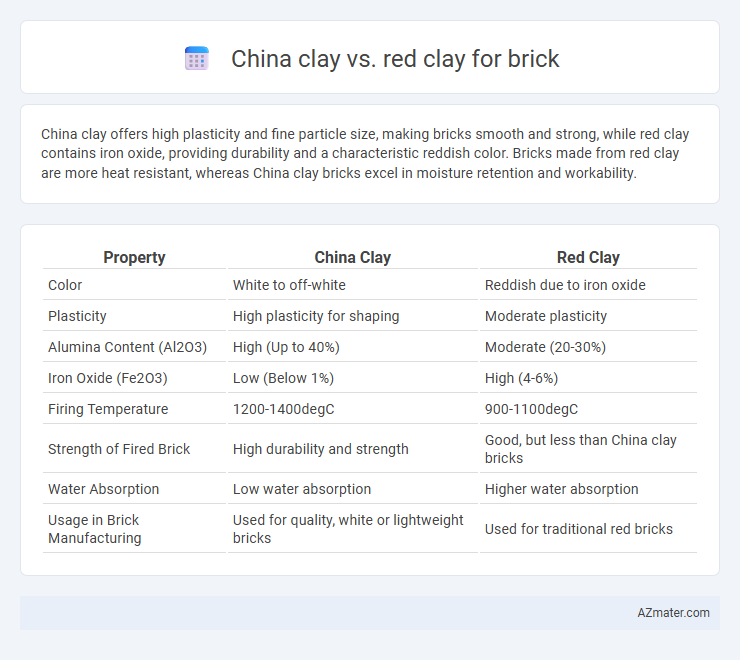China clay offers high plasticity and fine particle size, making bricks smooth and strong, while red clay contains iron oxide, providing durability and a characteristic reddish color. Bricks made from red clay are more heat resistant, whereas China clay bricks excel in moisture retention and workability.
Table of Comparison
| Property | China Clay | Red Clay |
|---|---|---|
| Color | White to off-white | Reddish due to iron oxide |
| Plasticity | High plasticity for shaping | Moderate plasticity |
| Alumina Content (Al2O3) | High (Up to 40%) | Moderate (20-30%) |
| Iron Oxide (Fe2O3) | Low (Below 1%) | High (4-6%) |
| Firing Temperature | 1200-1400degC | 900-1100degC |
| Strength of Fired Brick | High durability and strength | Good, but less than China clay bricks |
| Water Absorption | Low water absorption | Higher water absorption |
| Usage in Brick Manufacturing | Used for quality, white or lightweight bricks | Used for traditional red bricks |
Introduction to China Clay and Red Clay
China clay, also known as kaolin, is a fine, white clay with high plasticity and low impurity levels, making it ideal for producing smooth, high-strength bricks with excellent durability and resistance to weathering. Red clay, rich in iron oxide, naturally imparts a characteristic reddish hue to bricks and offers robust structural integrity but tends to have lower plasticity and higher impurity content compared to China clay. Both clays are essential in brick manufacturing, with China clay preferred for premium quality and refined finishes, while red clay is primarily used for traditional construction bricks due to its abundance and cost-effectiveness.
Geological Origins of China Clay vs Red Clay
China clay, or kaolin, primarily originates from the chemical weathering of feldspar-rich rocks, especially granites, in humid temperate regions, resulting in fine, white, and highly pure clay minerals. Red clay forms from the intense weathering of iron-rich sedimentary and igneous rocks in tropical and subtropical climates, characterized by its iron oxide content that imparts a distinct red hue. The geological origins influence their mineralogical composition, plasticity, and firing behavior, critical for brick manufacturing quality.
Chemical Composition Differences
China clay, primarily composed of kaolinite (Al2Si2O5(OH)4), exhibits high silica and alumina content with minimal iron oxide, resulting in a white to light-colored brick. Red clay contains significant amounts of iron oxides (Fe2O3), imparting a reddish hue and higher plasticity due to its iron and lime content. The chemical composition differences influence brick properties, such as color, firing temperature, and strength, making China clay suitable for white or light bricks and red clay preferred for traditional red bricks.
Physical Properties Comparison
China clay exhibits a finer particle size and higher plasticity compared to red clay, resulting in superior workability for brick molding. Red clay contains higher iron oxide content, which contributes to greater thermal stability and strength after firing. The lower moisture absorption rate of China clay enhances the durability of bricks made from it, while red clay offers better color consistency due to its mineral composition.
Suitability for Brick Manufacturing
China clay, or kaolin, offers excellent plasticity and fine particle size, making it highly suitable for producing smooth, high-quality bricks with a uniform texture. Red clay contains higher iron oxide content, which imparts a reddish hue and contributes to the brick's strength and durability, ideal for structural applications requiring robust performance. The choice between China clay and red clay depends on desired brick characteristics, with China clay favored for lightweight, fine-textured bricks and red clay preferred for traditional, strong, and weather-resistant bricks.
Strength and Durability of Bricks
China clay bricks exhibit high compressive strength and low porosity, resulting in superior durability and resistance to weathering compared to red clay bricks. Red clay bricks, while traditional, tend to have higher water absorption rates, which can reduce their long-term structural integrity under harsh environmental conditions. The mineral composition of china clay, primarily kaolinite, enhances the brick's mechanical properties, making it ideal for load-bearing constructions requiring enhanced strength and durability.
Color and Aesthetic Considerations
China clay bricks exhibit a pale or white color that offers a clean, modern aesthetic ideal for light-toned architectural designs, while red clay bricks provide a traditional, warm reddish hue that enhances rustic and classic appearances. The color variation in red clay results from iron oxide content, contributing to its rich, earthy tones that weather well and add character over time. In contrast, china clay's neutral shades allow for versatile finishing options and complement diverse color palettes, making it suitable for contemporary construction projects.
Cost and Availability
China clay offers a smoother texture and higher plasticity but tends to be more expensive and less readily available in large quantities compared to red clay. Red clay is more abundant and widely sourced, making it a cost-effective choice for brick manufacturing in many regions. The lower price and greater accessibility of red clay often outweigh the specialized qualities of china clay in brick production.
Environmental Impact and Sustainability
China clay bricks typically have lower environmental impact due to their abundant availability and minimal processing requirements, leading to reduced energy consumption and greenhouse gas emissions. In contrast, red clay bricks often require more intensive mining and firing processes, contributing to higher carbon footprints and soil degradation. Choosing china clay bricks supports sustainability by promoting resource efficiency and reducing ecological disturbance compared to traditional red clay alternatives.
Final Recommendations for Brick Selection
China clay bricks offer superior smoothness and workability, ideal for applications requiring fine detailing and a uniform finish, while red clay bricks provide greater strength and durability due to their higher iron oxide content. For structural projects demanding robust load-bearing capabilities and weather resistance, red clay bricks are recommended, whereas China clay bricks suit decorative purposes and indoor use where aesthetic appeal is prioritized. Selecting the appropriate brick type depends on balancing mechanical properties with visual requirements to ensure optimal performance and longevity.

Infographic: China clay vs Red clay for Brick
 azmater.com
azmater.com